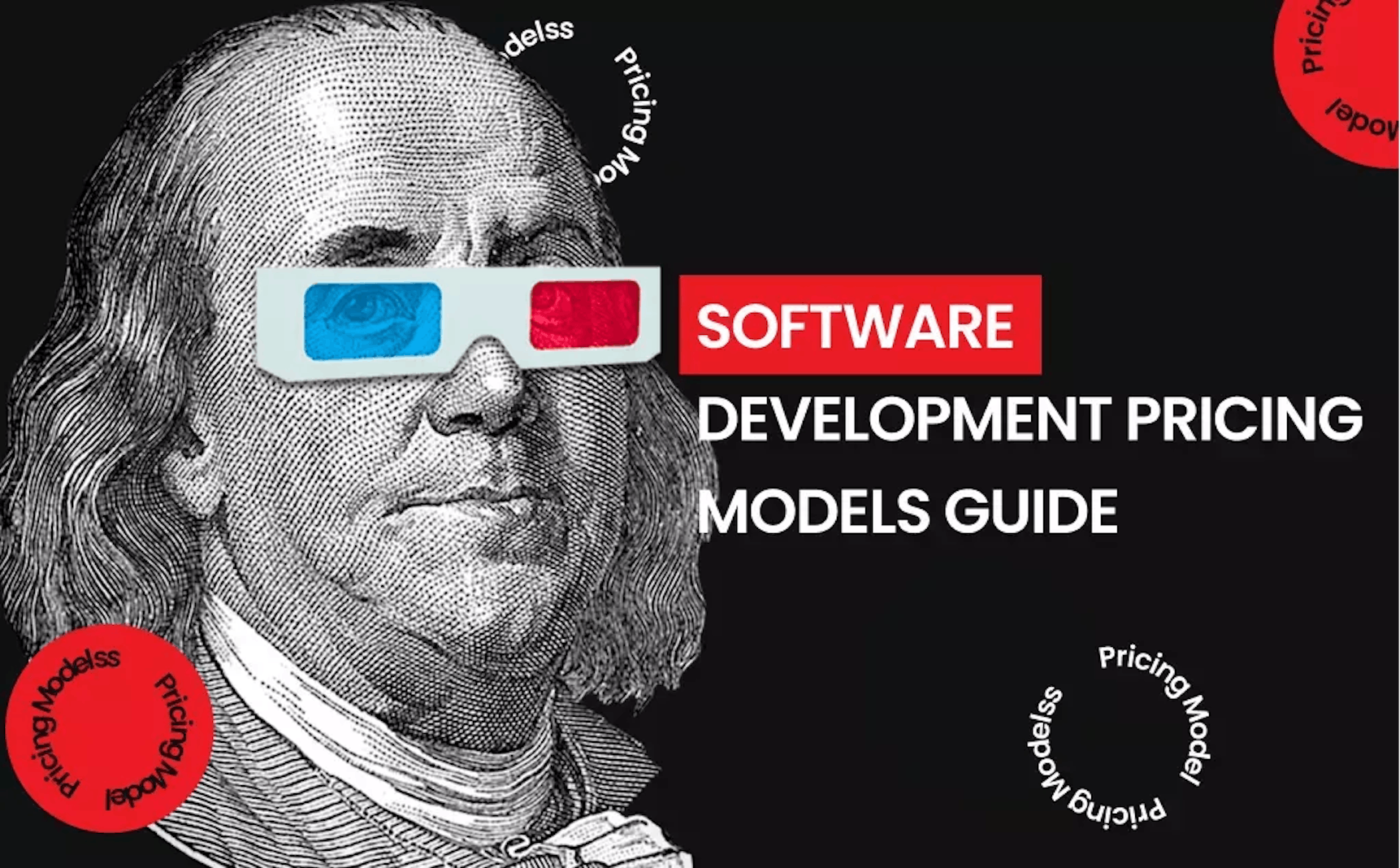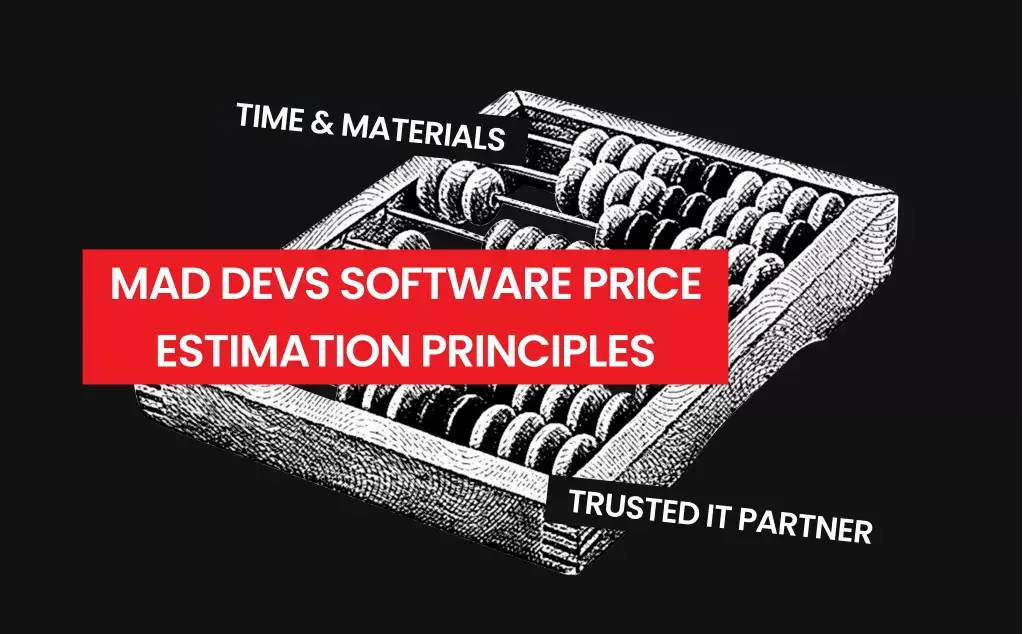Historically, organizations approached software development outsourcing as a black box where you throw away things you don't want to do. The field is changing as the emerging markets have proved to provide quality and shown the advantages of higher dollar purchasing power.
With so much at stake, traditional outsourcing engagement models thus moved towards partnership models. So now, businesses increasingly outsource things they can't do.
As a result, the emerging cooperation models have created numerous pricing models.
However, once you start digging deeper with your research and evaluating IT contractors' proposals, you'll start to see not only the big difference in total cost but also the difference in pricing models used to calculate the cost.
Ultimately, you may feel like companies are trying to take advantage of your lack of experience, and you can't identify a potential long-term partner.
In this publication, Mad Devs Customer University addresses your puzzling questions about pricing models with clarity and transparency.
What are the 8 software pricing factors?
Unfortunately, it can be hard to determine the exact cost of a software development project. Unlike building products from an assembly line, estimating the cost of a software development project involves taking into account various factors.
1. Human resources
The number of people who are involved in the project will have a huge effect on the cost of the project. You will need to hire a team of developers if you are not outsourcing the project. The size of the team depends on how complex the project is and how experienced the individuals are.
Your team's work environment will also affect how productive they are. Having a good working relationship with one another will help them become more efficient. There may be issues that they need to resolve, but the more projects they work on, the more they will be able to improve their efficiency.
The ability of your team to avoid conflict and work efficiently will have a huge impact on the project's budget. Make sure that everyone on the team is qualified and has the necessary skills to carry out their duties. Overworking the team can cause them to waste time and make them more prone to errors.
2. Project complexity & size
The complexity of a software application is also a factor that will affect the cost of the project. It can be very challenging to develop a complex program due to the number of steps and calculations that it requires.
The size of the software that you're developing will also be influenced by the number of screens that will be built. Having too many screens will increase the cost of the project.
3. Software functionality
One of the most important factors that will affect the cost of a software project is the functionality of the application. Having too many features will increase the cost of the development. It can also take longer to build and test a large number of applications.
4. Scope of work
The larger the scope of the project, the more expensive it will be. Although the project will likely have a fixed schedule and human resources, the scope can change over time. This is because constant stakeholder feedback will help determine the cost and the quality of the project.
5. UX/UI
The cost of a custom design depends on the features and scope of the project. Having a well-designed and engaging user interface is very important for a successful software development project. The right mix of animations, visual elements, and unique navigation elements will keep your users coming back.
6. Integrations
Another factor that can affect the cost of a software project is the integration of its features with other business applications. For example, having multiple third-party tools such as CRM will increase the cost of the project.
7. Migration
Different migration techniques and the unique requirements of different storage vendors can also add to the complexity of the process. Having a customized approach is also important to ensure that the data that you're moving will fit seamlessly into another system.
8. Extra expenses
Even though you're paying for the software, you should also consider the additional costs that the service provider might charge. These costs might not be related to the developers' hourly rates. It can be necessary if the complexity of the project increases or there is technical debt.
Aside from the hourly rate, there are also additional costs that the service provider might charge. These additional costs can pile up and add up to a huge bill.
Some businesses will also require that they pay for the licenses that the developers will need to complete the project. Others will require that they pay for the infrastructure costs associated with buying or leasing software.
Most people don't realize that there are also maintenance fees that are included in the cost of a software development project. These fees can range from minor repairs to security updates.
So when we've covered the major factors that influence project cost, we can move to pricing models.
What are pricing models in IT industry?
It can be overwhelming to build software from scratch. Not only does it involve writing code, but it also involves various phases such as architecture, design, testing, and deployment.
To avoid getting bogged down by the various steps involved in building a robust software solution, companies should keep in mind that there are various pricing models available. They should also be aware of the premium options that are available for their project.
With pricing models, companies can easily understand what they are paying for and what benefits they will get from their projects. There are several types of pricing models that can help companies develop software: fixed price, custom software development, time and material, outstaffing, dedicated team, hybrid, milestone and gain-sharing model.
Let's look closer at each of them.
Fixed price model / Waterfall
As the name itself implies, a fixed price model is an agreement between a business and an IT outsourcing company on a strictly predefined set of requirements to be accomplished for a predefined price.
Note: The terms “fixed price model” and “waterfall model” are used interchangeably.
A fixed price model is an ideal mechanism for projects with a clear scope, established project management methodologies, and a stable set of requirements. For a successful collaboration, a team and a service provider should have a good grasp of project requirements and a conducive working environment in place and should be aware of each other's skills and needs.
Clients with tight budgets and those who require absolute certainty tend to incline towards the fixed price model.
IT service providers absorb the majority of the risk. However, this risk coverage is, in fact, coming from the customers' pockets. Keep in mind that in 100% of cases, the service provider charges a 20%-50% premium on top of the real cost because the provider must consider various risks and ensure profitability for the entire project timeline.
In the early stages of IT outsourcing, almost everybody worked using the fixed price model, and it created numerous inconveniences and issues for both service providers and clients.
Problems and pitfalls of the fixed cost pricing model
The above explanation of the fixed costs pricing models is what you'll commonly hear and read on the Internet. Let's dig deeper, here is what they don't necessarily tell you.
Negotiation mess: As the contract defines the scope of the work and specifications, any deviation from this scope will create a negotiation mess. As problems and new needs emerge, it's difficult to understand which party should absorb the additional cost. So instead of moving the project forward, both parties will be sending new additions to the contract back and forths, so a lot of time can be wasted.
Undeniable utopia: Dealing with a list of clearly defined specifications and requirements, unfortunately, is a utopia. In a normal project, adjustments and alterations will inevitably be needed at some points. Unless, of course, you are required to automate a 100-year-old process that will maintain the status quo forever. Or your project is tiny.

Custom software development as a service (CSaaS)
Custom software development as a service (CSaaS) is a cloud-based delivery model for custom software development projects. In this model, the development team works remotely and delivers the software as a service.
Unlike traditional models where software development is typically project-based, CSDaaS offers ongoing, on-demand development services that can be tailored to the client's evolving needs.
With the SDaaS model, you are charged a predetermined monthly fee for a defined set of services. This fee covers all essential functions needed to develop, maintain, and enhance your software product. This approach provides a clear and predictable cost structure, simplifying financial planning and budgeting.
The SDaaS subscription model functions similarly to Netflix, offering you continuous access to top-tier software development professionals with proven expertise.
But remember, that SDaaS model is ideal in the following scenarios:
- If you need to stay within a predefined monthly budget for software development, the SDaaS model offers a predictable cost structure, helping you manage finances effectively.
- If you want the ability to adjust project priorities and scope dynamically as your product evolves, SDaaS provides the flexibility to make changes without the constraints of traditional models.
- If you prefer to have a development company actively involved in guiding and advising you, SDaaS ensures that you have access to a team of experts who can offer valuable insights and recommendations.
Problems and pitfalls of CSaaS
Final budget predictions: While initial estimates provide a starting point, the final budget can be uncertain. Project scope and requirements may evolve during development, leading to changes in the estimated cost
Dependency on service provider: Relying on an external service provider means that you must trust their capabilities and responsiveness, which can impact your project if their performance falters.
Time and material (T&M) pricing model
User behaviors and needs change faster than a typical software development project lasts. Often, you as a client can only predict possible intentions and perceptions of users. Meanwhile, MVP requirements can't be defined precisely. Thus, during the development process, new product requirements and new flows will appear, and they will affect the total software price as well.
The time and material price model provides agility. Flexibility in software development enables you to create a product that the market indeed needs and will use.
Also, this model is the most transparent one. In the fixed price models, where the probability of risk is high, IT outsourcing companies charge an extra 20%-50% on top of their real estimation to be able to absorb the risk and ensure profit. In the time and material model, you as a client always pay the real price without any premiums. Thus, you always know where your money goes.
With this pricing model, the service provider and the client organization normally agree upon an hourly rate. The billing is based on the developers' levels of education and experience.
Problems and pitfalls of the T&M pricing model
Uncertainty: The company operating under the time and material pricing model should provide specific processes designed for the partners to be able to control the costs. Otherwise, you might fall into a disadvantageous situation of overpaying.
Deep involvement: T&M pricing models require your deep involvement in the development of a solution to make sure that the IT company is moving in the right direction and spending the correct number of hours.
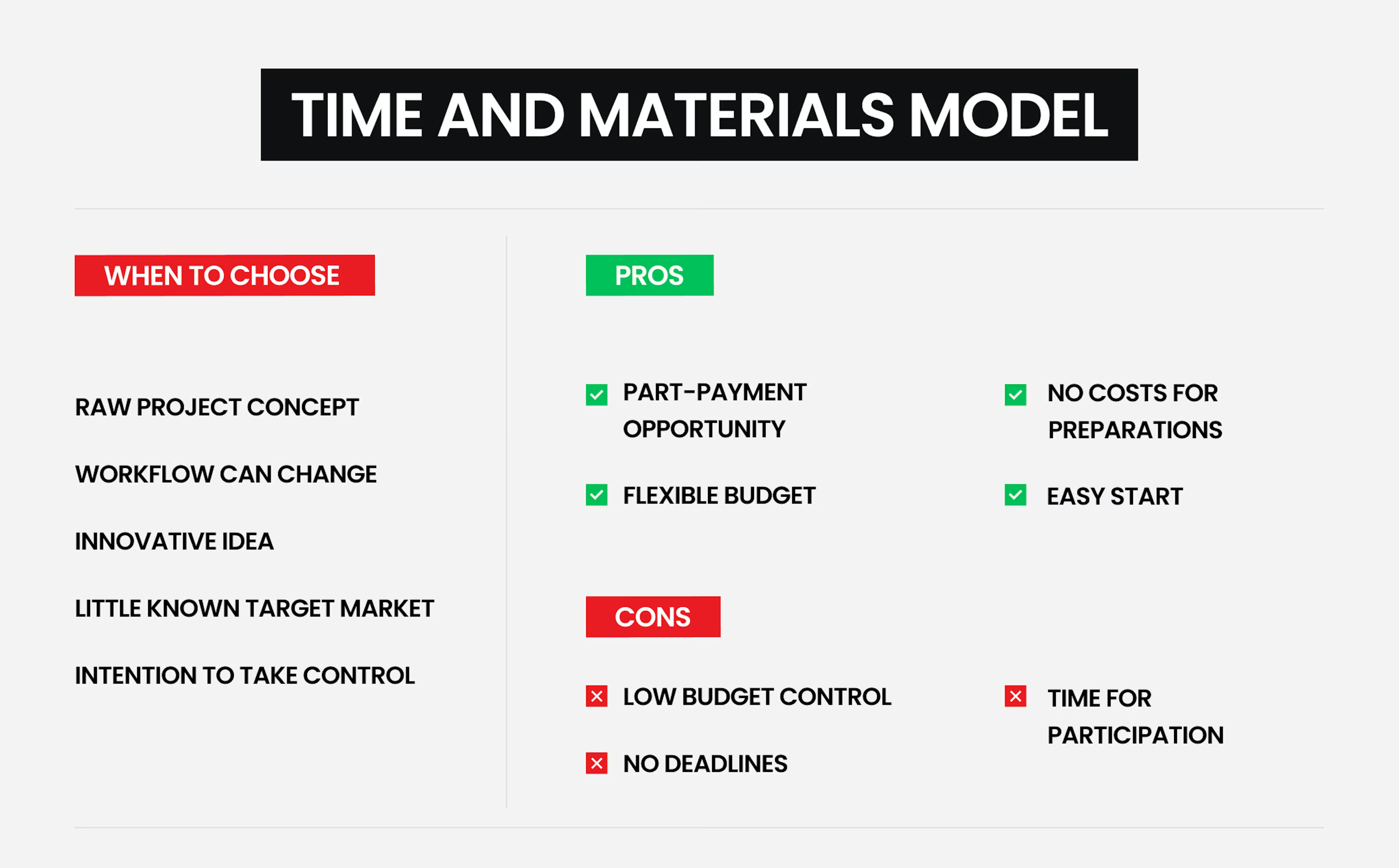
How to estimate the final price using the time & material pricing model?
Answers to this question will vary from company to company. We can describe our best practices in approaching price estimation. Our methods are not unique: they can be found in other transparent IT outsourcing companies.
At Mad Devs, we approach every new customer as a new case. We don't send to customers proposals we've already used in other projects.
During the first meeting, we meticulously examine the clients' vision and the users' needs. A special SWOT analysis team consisting of senior-level developers with expertise in the required field then creates a detailed roadmap and estimates the scope of the project.
The roadmap created by the SWOT analysis team consists of:
- Typical tasks: team onboarding, DevOps, testing
- Specific tasks
- Team composition
Total estimation for typical tasks can easily be calculated, and the SWOT analysis team creates approximate estimates for specific tasks and multiplies them by the developers' hourly rate.
This approach enables us to determine the right pricing and answer all potential questions regarding how the final estimate was calculated. Additionally, the clients themselves have the power to shape the final price by altering the scope of work or suggesting changes in the team composition.
Hybrid pricing model
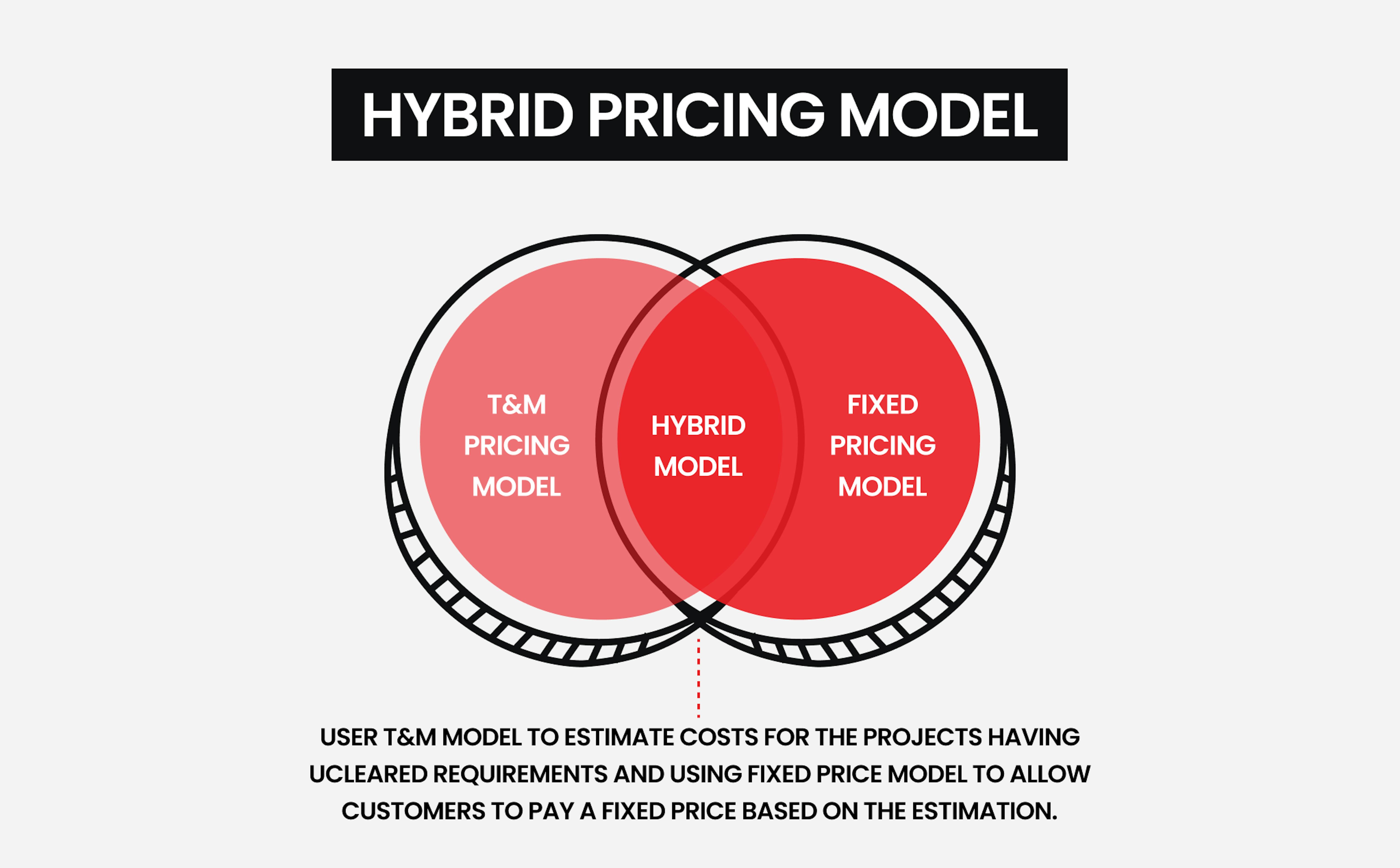
The hybrid model is a cost-effective alternative to the traditional T&M model for projects that do not have specific requirements or clear-cut goals. It allows customers to set a fixed price based on the estimate. This model has the best features of the two models – fixed priced and time & material, such as the ability to deploy resources and the well-aligned processes.
The hybrid model is ideal for projects with unclear objectives and requirements at the start. It allows for feedback and input during the early stages, but it can be refined over time to deliver the best possible results. This model is also ideal for customers who prefer to pay one-time or hourly.
It allows customers to keep their budgets flexible and avoid compromising on the quality of their product or application. It also provides a controlled environment for the service provider.
Problems and pitfalls of hybrid model
Complexity: Hybrid models can be intricate to understand and implement, especially when combining multiple pricing components or tiers.
Unclear cost forecasting: Since hybrid pricing combines different models, it can be challenging to accurately predict the total cost.
Potential for misalignment: Conflicting expectations between fixed-price certainty and the flexibility needed for T&M work can cause issues.
Milestone pricing model
Milestone billing is a payment method where the total project cost is divided into smaller milestones. Clients pay a portion of the total cost upfront, and then make additional payments as each milestone is completed.
Much like the time and materials model, this approach involves paying based on the time spent and the hourly rate for different tasks, such as UI/UX design, QA, or development.
Under the milestone pricing model, payments are linked to the completion of specific project phases. You pay for the time the software development team spends on achieving a particular milestone, as well as the resources they utilize in this process. This structure ensures that you are charged based on the actual work completed and the resources used during each phase of the project.
One of the key benefits of the milestone pricing model is that you only pay upon the successful completion of each milestone. This eliminates the need for prepayments and ensures that you are billed based on tangible results.
The milestone pricing model is best suited for projects where there is a foundation of trust between the customer and the development team. It is particularly effective for:
- Assessing team performance: Evaluating the capabilities and working style of the development team.
- Building MVP projects: Projects with clearly defined milestones and initial goals.
- Projects with flexible budgets: Scenarios where the budget is not strictly constrained and can accommodate potential adjustments.
Problems and pitfalls of the milestone model
Risks: The milestone pricing model involves moderate risks for both customers and software vendors. Additional development hours, particularly for revisions, can lead to disputes over payments and delivery expectations. There is also the risk of underpayment or underdelivery if milestones are not clearly defined.
Budget: The budget can be unpredictable as it heavily depends on the amount of time the team spends developing specific features and the changes required. This variability can make it challenging to estimate the total cost of the project.
Timeline: Similar to the budget, the timeline for project completion can be rough and subject to delays. The overall project duration may be uncertain, which can impact your planning and scheduling
Outstaffing pricing model
Outstaffing means handing tasks over to individual specialists working for a service provider company. Organizations engage in outstaffing when they lack the expertise or capacity to complete the tasks in-house. Usually, hiring experienced developers might take a lot of time, and sometimes, you don't have enough authority to attract the best personnel. This model provides human resources for whole projects or just parts of projects as needed.
The model is ideal for clients who are looking to hire specialists on a short-term basis. The clients don't have to pay for recruiting, and terminating the contract is easy.
The outstaffing pricing model can use predefined rates like the time and material model or fixed price in the form of a regular salary without covering additional benefits, taxes, vacations, and coffee breaks.
And since the project is managed by the client organization, closer monitoring of performance provides more accurate cost control. To confirm the seniority level of the professionals being hired, most IT outsourcing companies let clients interview and test outstaffed team members.
Problems and pitfalls of outstaffing pricing model
Hidden costs: Although the model may seem cost-effective, additional costs for training, management, and communication tools can arise.
Limited accountability: Since outstaffed developers follow the client's directions, responsibility for project outcomes can be blurred.
Communication barriers: Time zone differences, language, and cultural differences can lead to communication challenges and project delays.
Intellectual property: Ensuring clear ownership and data privacy can be challenging.
Dedicated team model
This type of model is ideal for companies that need to quickly expand their software development team. The most significant advantage of a dedicated team pricing model is its ability to control the number of people that the team members are allowed to work with. You can also monitor and interview the members of the team.
Unlike an in-house team, a dedicated team model eliminates the need for hiring and training new employees. Instead, you can enjoy the services that the team provides. With a dedicated team, you can also pay the monthly salaries of the employees that you have hired.
Problems and pitfalls of dedicated team model
Higher long-term costs: While cost-effective for ongoing projects, it may become expensive for shorter or less complex tasks due to the long-term commitment.
Integration challenges: Integrating an external team with in-house staff can be difficult, affecting collaboration and project alignment.
Dependency on vendor: The client heavily relies on the vendor for management, which may limit control over the team’s daily activities or quality.
Let's look at the above pitfalls in more detail.
Before the project begins, it's important that the customer knows the exact amount of hours that the team members will be working on. This is because the hourly rate that the service provider charges is based on the number of hours that the team members will be working on.
Since you will control the whole project, you are responsible for the overall management of the team. You also need to make sure that the team members are working efficiently and effectively.
Instead of paying intervals, a dedicated team pricing model provides monthly payouts. This method takes into account the various costs associated with the project, such as salaries, administrative fees, and other fees. So, this model is effective only for long-term projects.
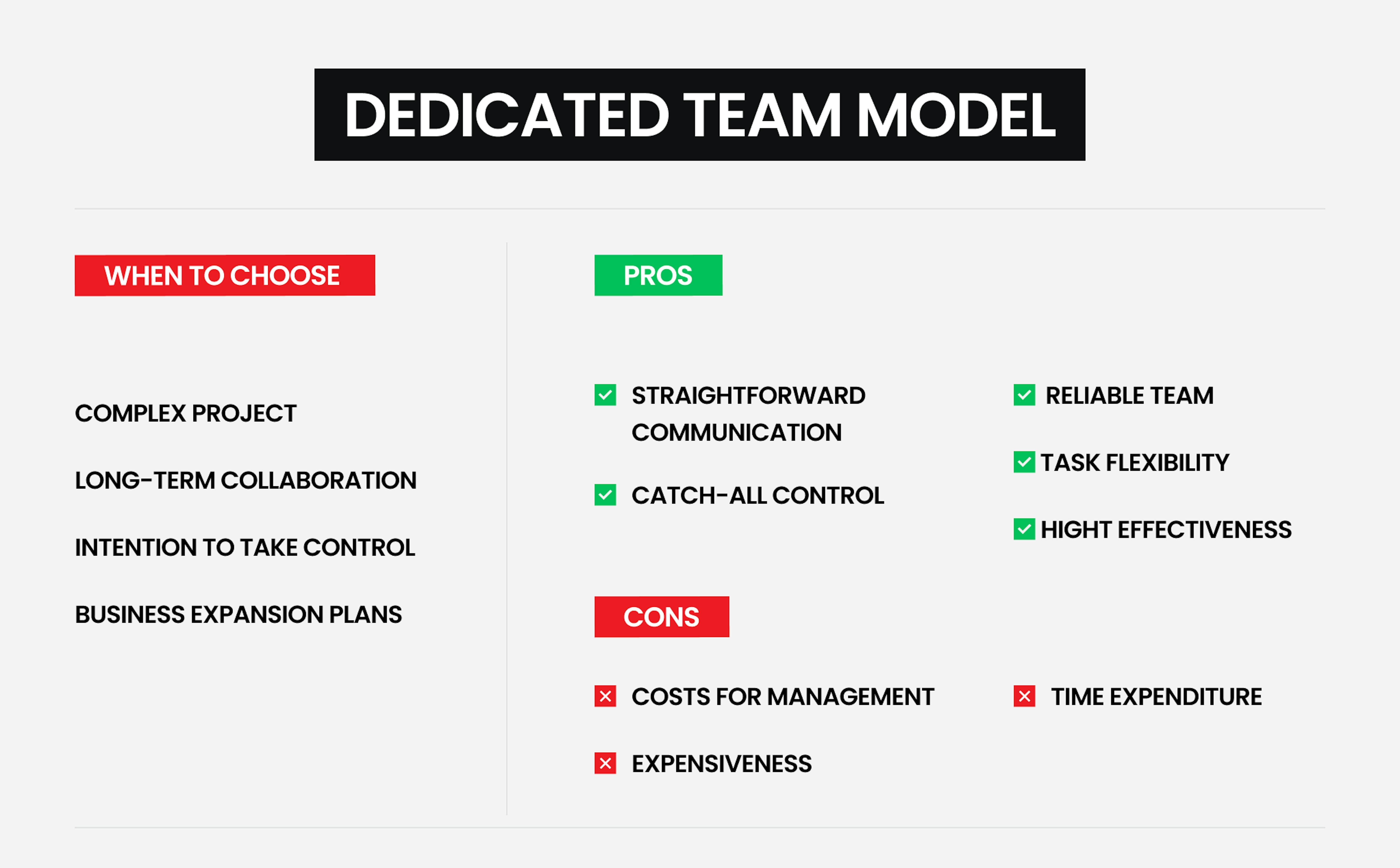
Gain-sharing pricing model
Future unicorn startups having great ideas but unable to attract the best employees and financial resources to boost their growth can pitch their product to IT outsourcing providers.
The providers in some cases might operate as investors and become co-founders of a startup. In contrast to traditional monetary investments, the startups ask for labor expertise. It is called the gain-sharing pricing model.
However, this pricing model is usually not the most attractive to IT service providers. These pitches often come from startups that lack a solid foundation and are looking for freebies.
To those who are interested in this pricing model, we have a few recommendations:
- Develop a clear monetization strategy and make sure you know how your project is going to generate profit in the future
- Conduct market-fit analysis
- Have a clear vision of how your product is going to meet users' needs
Also, IT outsourcing companies never cover 100% of costs but only provide a discount. It puts the responsibility for faster success on startup founders’ shoulders, and thus they take their idea more seriously.
No matter how much Mad Devs or any other vendor is interested in supporting startups and becoming responsible partners, we can accept only a limited amount of projects under our umbrella.
Problems and pitfalls of gain-sharing pricing model
Risk for vendors: Vendors may face financial risk if the project doesn't achieve expected results, even if external factors beyond their control affect performance.
Difficult to scale: As the project grows in complexity, tracking and attributing gains to specific actions becomes harder, complicating the payment structure.
Delayed payments: Payment is tied to long-term performance, which can lead to cash flow issues for vendors during the project.
Complex metrics: Defining clear, measurable success criteria can be difficult, leading to disagreements between the client and vendor over what constitutes "gain."
After having thoroughly analyzed the various pricing models types, it's now time to start writing the contract that will best suit both you and the service provider.
How to choose the pricing model for software development?
Choosing the suitable software development pricing model involves considering several key factors:
⏹ Project size — The scale of your project determines the appropriate pricing model.
- For small projects needing only a few developers, models like time and material (T&M) or milestone-based pricing may be sufficient.
- For larger projects requiring a full team, including QAs, designers, and project managers, models like software development as a service (SDaaS) or a dedicated team approach might be more suitable.
⏹ Scope — The complexity and detail of the project play a significant role in the choice of pricing model.
- Flexible requirements can benefit from the adaptability of T&M, SDaaS, or dedicated team models.
- Conversely, fixed-price models may be risky for projects with evolving scopes.
⏹ Goals — Your objectives should align with the chosen pricing model, whether it’s a quick performance boost, minimum viable product (MVP) development, or ongoing maintenance of existing software. The model should reflect your specific goals and needs.
⏹ Expected duration — The project's duration can influence the pricing model's choice. Fixed-price contracts are often best for short-term projects, while T&M, SDaaS, or dedicated team models are better suited for medium to long-term engagements.
⏹ Budget expectations — If maintaining control over monthly expenses is crucial, consider pricing models like SDaaS, fixed-price, or dedicated teams that offer more predictable costs. Models like T&M or milestone-based pricing may result in variable monthly payments.
⏹ Level of control and involvement — Some models will be more appropriate depending on how involved you wish to be. For wxample, SDaaS and fixed-price models typically require less client involvement, whereas T&M and milestone models demand more active participation from the client.
What should be included in a software development contract?
Service should be provided
The contract should include a section that describes the services that you expect from the service provider. This section should also include the project scope and any details that you need to protect both you and the partner from disputes.
The Services section should also include a discussion about the procedures involved in making changes to the scope of the contract. This should be done in writing so that both parties can make informed decisions.
Project time and cost
The contract's terms should also be summarized in terms that are easy to understand. This section also includes the project's timeline and the estimated cost of the project.
In addition, the contract should also include a statement that explains the responsibility of both parties for delays caused by the project. If the parties have already agreed on partial payments, this should also be included in the contract.
Testing
The acceptance testing section should also include a statement that clearly states the type of testing that will be performed on both the vendor and the client.
Intellectual property rights
It is one of the important sections. The software that's developed as the result of a project should also be clearly stated in the contract. This section should also include the terms and conditions that govern the use of the software.
Particularly it should include:
- Source code
- Any material that was developed during software development: wireframes, designs, plans, etc
The development company can only reassign the rights to the software that it created. If the software was developed using open-source tools, they will remain public.
Confidentiality
The confidentiality section should also be included in the contract to protect the information that the development company has stored about the project.
Most software development contracts contain confidentiality provisions that are usually maintained after the contract has been completed.
Flexible pricing models matter for Mad Devs' clients and that's why
Mad Devs primarily focuses on dedicated team, custom software development as a service, and outstaffing models because they align with the company's core values and the specific needs of many clients. Here's a breakdown of why these models are preferred:
- The dedicated team model fosters a strong sense of ownership and commitment among the developers. It allows for deep understanding of the client's business and project goals, leading to more efficient and effective development.
- Custom software development as a service (SDaaS) provides a scalable and cost-effective solution for clients. It eliminates the need for significant upfront investments and allows for flexible pricing structures.
- Outstaffing model offers flexibility and control to clients. It enables them to scale their development team as needed and manage the developers directly.
These models address potential drawbacks of other pricing approaches, such as fixed-price, time-and-material, and milestone-based.
Fixed price models can be risky if project requirements change, leading to additional costs or delays. Time and material models can result in unpredictable costs and timelines, especially for complex projects. Milestone-based models may face challenges if milestones are not met or if the project scope changes. These drawbacks can negatively impact the overall project outcome and client satisfaction. In contrast, Mad Devs' chosen pricing models offer a more flexible and transparent approach, reducing the risk of such issues and ensuring a smoother development process.
To experience the benefits of Mad Devs' pricing models and ensure a successful project outcome, contact us for a free consultation.

